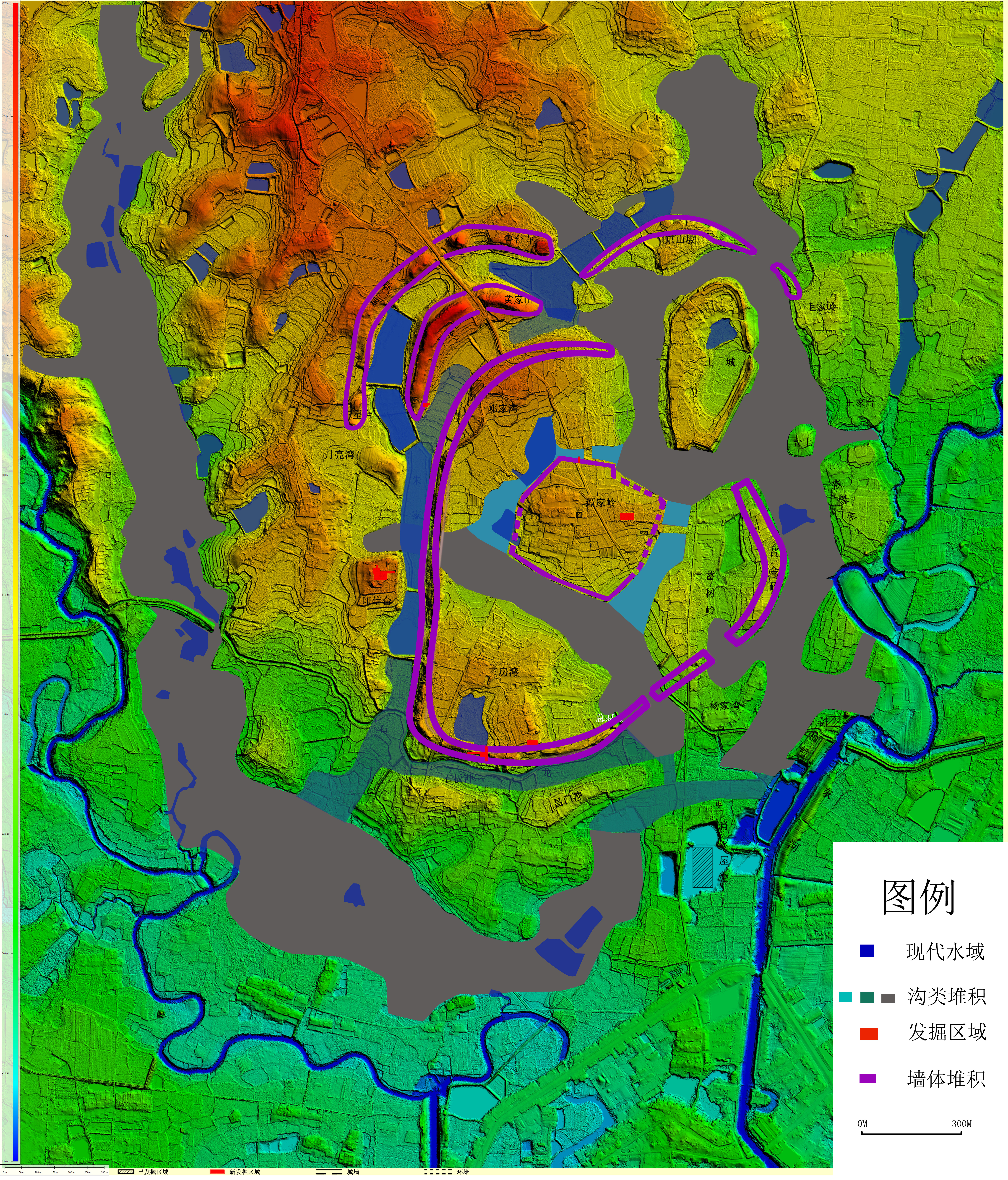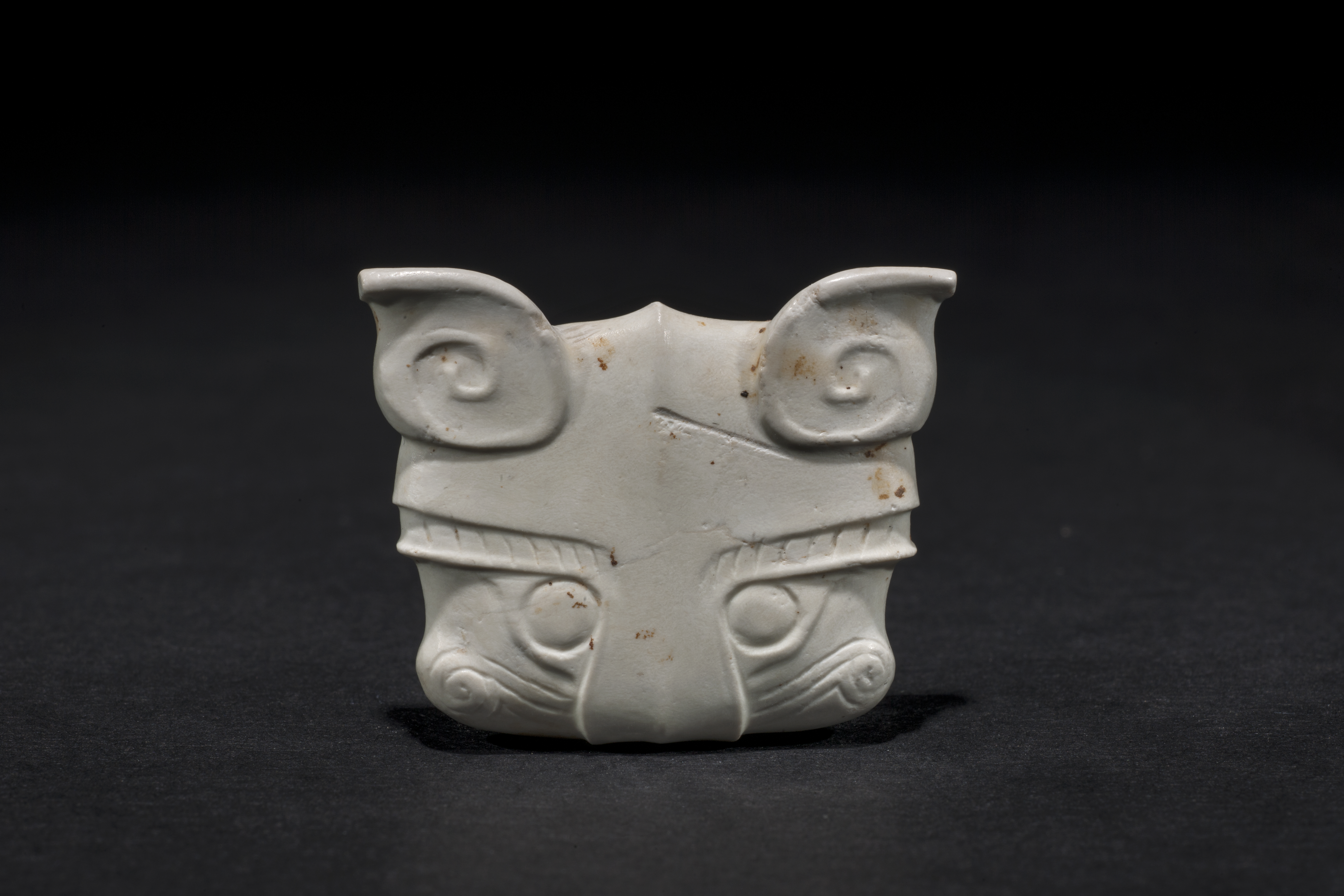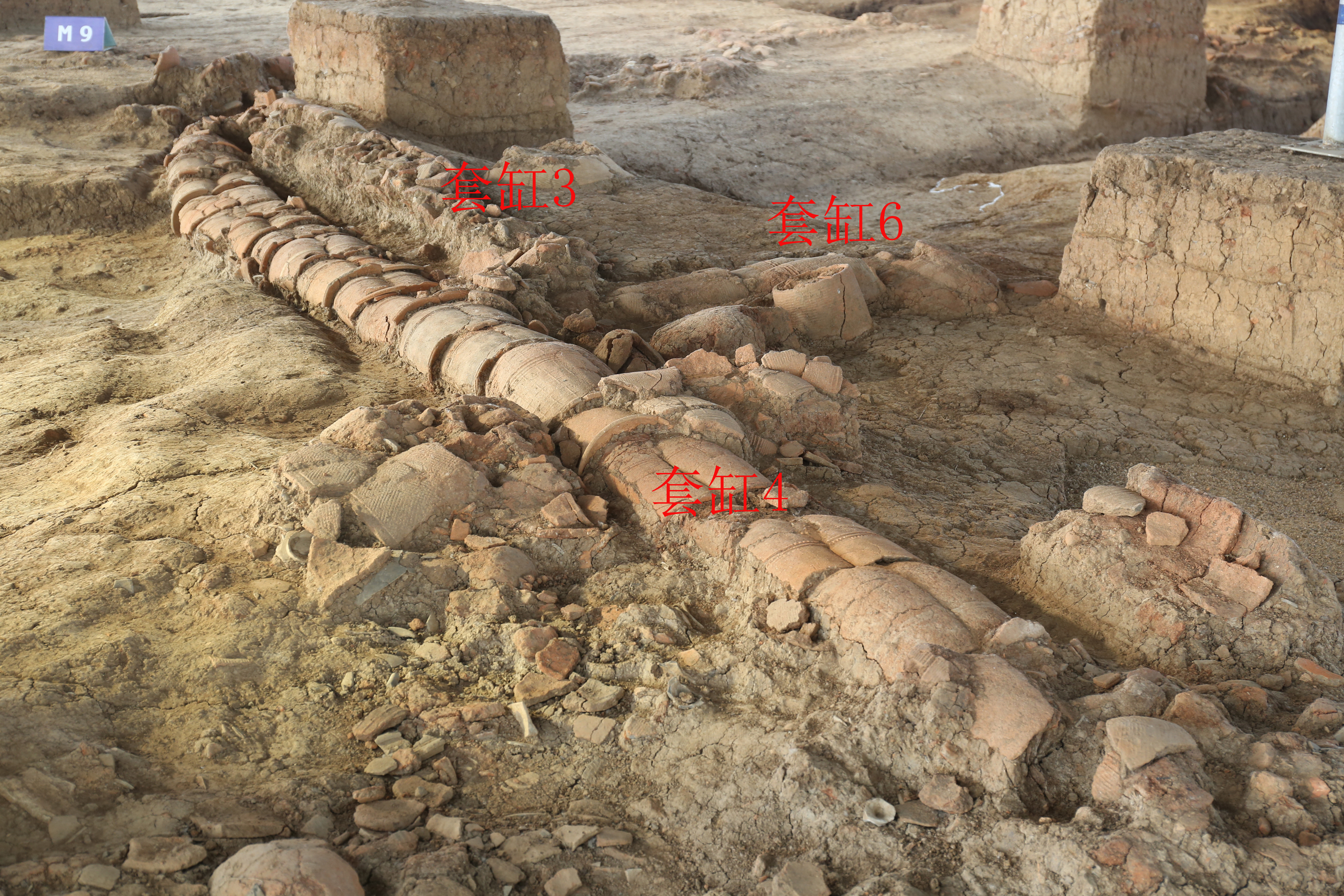长江中游地区史前文明的中心-石家河聚落考古新发现
New Discoeries at Shijiahe - a Central Prehistoric Settlement in the Middle Yangzi Region
孟华平 Meng Huaping
(湖北省文物考古研究所 Hubei Provincial Institute of Cultural Relics and Archaeology)
石家河遗址位于湖北省天门市石河镇,地处大洪山南麓、江汉平原北部的山前地带,是长江中游地区已知分布面积最大、保存最完整、延续时间最长的史前聚落群,面积约8平方公里。
石家河遗址最早发现于1954年。1955年~1992年,考古工作者多次调查、发掘石家河遗址,确立的考古学文化序列与谱系及以石家河城址为核心的聚落群奠定了石家河遗址研究的重要基础,发现的蕴含丰富史前文明信息的大型建筑、铜器、玉器、刻划符号、祭祀遗迹等是探索中华文明进程的重要内容。这里的考古学文化主要经历了油子岭文化(距今 5900—5100年)、屈家岭文化( 距今5100—4500年)、石家河文化(距今 4500—4200年)、后石家河文化( 距今4200—4000年)等4个发展阶段 。其中,从油子岭文化到屈家岭文化再到石家河文化的基本文化特征非常相似,可以说是一脉相承。但到后石家河文化时期,其整体文化面貌发生较大的改变,存在文化谱系上的断裂或突变。

为深入了解石家河遗址的布局结构、探讨石家河遗址在中华文明进程中的作用与地位,2008年,湖北省文物考古研究所对石家河遗址为中心的150平方公里的区域进行系统调查,确认史前遗址73处。2011年,发掘确认石家河城址东南段缺口存在城垣堆积。2014-2016年,湖北省文物考古研究所联合北京大学考古文博学院、天门市博物馆对石家河遗址核心区进行系统勘探,并重点发掘谭家岭、印信台、三房湾、严家山等遗址,共计勘探面积约3平方公里,发掘面积约3375平方米,取得一批新成果。
其一、勘探发现石家河遗址核心区域存在多重人工堆筑的大型城壕遗迹,为宏观上认识石家河遗址的布局结构提供了新视角。新发现的谭家岭城址位于石家河遗址的中心,平面大体呈圆角方形,城垣东西长440米、南北宽390米,城垣内总面积17万平方米,城壕内总面积则达26万平方米。

其二、发掘的谭家岭、三房湾、印信台、严家山等遗址,是深入研究石家河遗址聚落结构演变及石家河城址聚落功能区化的新物证。
谭家岭城址北部揭示的城垣由较纯净黄土堆筑而成,城垣顶宽约14.5米、厚约3.1米,城壕宽约30米、深达9米,城壕淤泥中残存一排木构遗迹,其始建年代属于油子岭文化晚期,是同时期中国发现规模最大的史前城址。谭家岭遗址东部高地揭示的后石家河文化时期随葬玉器的瓮棺葬、石家河文化晚期面积达144平方米的大型建筑台基残迹以及屈家岭文化早期的土坑墓地,初步反映出该区域聚落格局的变化状况。

三房湾遗址揭示的陶窑、黄土堆积、黄土坑、洗泥池、蓄水缸以及数以万计的红陶杯残件等,具有典型的制陶作坊特征,是一处石家河文化晚期至后石家河文化时期以烧制红陶杯为主的专业窑场。
印信台遗址主要揭露出五座人工堆筑的台基以及沿台基边缘分布的100余座瓮棺、扣碗等遗迹。台基之间的低地填埋大量石家河文化晚期的厚胎红陶缸、红陶杯等废弃品及少量人骨残骸,有些废弃的红陶缸还呈现排列有序、相互套接的状态,部分红陶缸上新发现多种刻划符号,是一处石家河文化晚期多次进行祭祀活动的特殊场所,也是长江中游地区目前发现规模最大的史前祭祀场所。
石家河城址南城垣西段缺口的城垣被石家河文化晚期的文化堆积叠压并叠压屈家岭文化早期的堆积,城垣之间的缺口宽约12米、残深2.6米,它至少在石家河文化早期依然存在,是人为设置的进出石家河城址的通道。
严家山遗址揭示的墙体堆积被石家河文化晚期的文化层堆积叠压,其年代不晚于石家河文化晚期。石家河文化晚期至后石家河文化时期石块堆积的石块属极易破碎的灰白色白云岩,且部分石块可见敲打、磨平、钻孔等痕迹,具有石器加工场所的若干特点。后石家河文化时期20座瓮棺葬仅见30余件玉器废料,反映出瓮棺葬主人身份的新线索。
其三,新发现一批后石家河文化时期的玉器,丰富了中华文明进程研究的内涵。谭家岭遗址5座瓮棺出土的240余件精美玉器是后石家河文化时期石家河遗址玉器的又一次集中发现,新见的神人头像、双人连体头像玉玦、虎座双鹰玉饰、玉牌饰、虎形玉冠饰、玉虎、玉鹰等,不仅类型丰富、造型生动,而且技术精湛,代表了史前中国乃至东亚地区玉器加工工艺的最高水平。
上述考古工作为我们深入认识石家河遗址聚落结构的演变、区域文明中心的形成及在中华文明一体化进程的作用等方面具有重要价值。
石家河遗址核心区域存在的多重人工堆筑的大型城垣类遗迹及人工开挖的城壕类遗迹并非短期形成,而是经历了比较漫长的发展过程,其聚落结构的演变大致可分为三个阶段。年代最早的谭家岭城址位于石家河遗址的中部高地,其始建年代早到油子岭文化晚期并使用至屈家岭文化早期,此时,始建于油子岭文化早期的龙嘴城址废弃,距龙嘴城址北约6公里的谭家岭城址则成为油子岭文化发展的新中心。屈家岭文化晚期至石家河文化时期,石家河遗址的聚落结构出现明显变化,面积达120万平方米的石家河城址横空出世,位于石家河城址中心的谭家岭城址废弃但转变为重要的居住中心,以石家河城址为核心面积达8平方公里的石家河遗址聚落群开始形成。在石家河文化晚期,石家河城址外西、北部存在的两条人工堆筑的黄土墙体堆积可能系石家河城址的扩建工程。后石家河文化时期,石家河遗址的聚落结构再次发生显著变化,原有的城壕体系瓦解,聚落分布比较零散,未发现明显的聚落中心。
长江中游地区的文明化进程大约开始于油子岭文化时期,出现了一系列社会复杂化现象,其中的谭家岭城址是同时期规模最大的聚落。发展到屈家岭文化至石家河文化时期,长江中游地区的社会复杂化程度进一步加剧,成为中华早期文明多元格局中的重要代表。此时的长江中游地区已经形成文化面貌高度相似的文化统一体,存在十余座规模不等的城址所构成的网络体系,出现聚落等级与社会阶层的明显分化,社会分工日益细化,石家河遗址以其丰厚的文化积淀,无论是从长江中游地区规模最大的石家河城址看,还是从谭家岭大型居住址、印信台大型祭祀遗址、三房湾大型制陶作坊遗址等聚落功能的专门分区看,还是从出土遗物中刻划符号、孔雀石的代表性与出土遗物的丰富度看,无疑可视为长江中游地区文明的中心,具有文化引领与文化辐射的重要地位。
多元一体是中华文明进程的重要特点。长江中游地区以石家河遗址为中心的区域文明发展进程到后石家河文化时期并未依照自身的轨迹运行,此时出现的非本区域文化传统的随葬玉器的瓮棺葬俗、大量涌现的源自中原王湾三期文化的陶器以及部分山东龙山文化因素等现象表明,长江中游地区早期文明的发展进程遭受黄河文明的强烈冲击被迫中断,以石家河遗址为代表的后石家河文化已被整体纳入黄河文明的进程中。虽然以石家河城址为核心的聚落模式瓦解,尚未发现这一时期明显的中心聚落,但石家河遗址多地揭示出的精美玉器、制玉遗迹、陶塑艺术品、铜器等,显示这里仍然存在发达的手工业,其文化依然相当繁盛,且瓮棺葬主人之间存在明显等级身份的分化,石家河遗址仍然可作为在后石家河文化时期中华文明一体化进程的典型代表。
The Shijiahe site is located in the town of Shihe in Tianmen City, Hubei Province. It is situated at the southern foothills of the Dahong Mountain and the piedmont area of the Northern Jianghan Plains. Shijiahe, measuring an area of eight square kilometers, is the largest, most well-preserved, and, chronologically, the longest-spanning prehistoric settlement excavated to date in the Middle Yangtze River Valley.
Shijiahe was discovered in 1954. Between 1955 and 1992, multiple archaeological surveys and excavations were conducted at the site, which established the archaeological cultural sequence and Shijiahe’s position as the core of a settlement cluster, laying the foundation for the study of the Shijiahe site. The large-scale architecture, bronzes, jades, inscribed symbols, and ritual features uncovered have provided an abundance of information on prehistoric civilization, crucial for exploring the development of Chinese civilization. Shijiahe experienced four archaeological cultural phases including the Youziling culture (5900BP to 5100BP), the Qujialing culture (5100BP to 4500 BP), the Shijiahe culture (4500BP to 4200BP), and the Post-Shijiahe culture (4200BP to 4000BP). Among these archaeological cultures, the cultural development from the Youziling culture period to the Shijiahe culture period was very similar, indicating that the Youziling, Qujialing, and Shijiahe cultures were all closely related to one another. However, after the Shijiahe culture period, the material culture at the site experienced a relatively substantial change. This signifies that by this period, the site experienced a shift or a rupture in the archeological cultural genealogy.
In 2008, in order to understand the layout and structure of Shijiahe and to examine the role and function of the site in the development of Chinese Civilization, the Hubei Provincial Institute of Cultural Relics and Archaeology conducted a systematic archaeological survey of a 150 square kilometer area centered on the Shijiahe site. 73 prehistoric sites were discovered in this survey. In 2011, excavations confirmed the remains of a city wall in the gap at the southeastern portion of Shijiahe city site. Between 2014 and 2016, The Hubei Provincial Institute of Cultural Relics and Archaeology, Peking University’s School of Archaeology and Museology, and the Tianmen Museum collaborated on a coring and excavation project at the core area of Shijiahe. Sites such as Tanjialling, Yinxintai, Sanfangwan, and Yanjiashan were excavated. The total coring area measured approximately three square kilometers and the total excavation area measured approximately 3375 square meters. This project yielded several significant results.
First, based on the coring results, the remains of multiple large, man-made city moats are present in the main area of Shijiahe, providing a macroscopic understanding of the layout and structure of the site. The newly discovered Tanjialing city site is situated in the center of Shijiahe and is roughly the shape of a rounded square. The city wall measures 440 meters in the east-west direction and 390 meters in the north-south direction. The area encircled by the city walls measures 170,000 square meters, while the area encircled by the city moat measures 260,000 square meters.
Second, the discovery and excavation of archaeological sites such as Tanjialing, Sanfangwan, Yinxintai, and Yanjiashan have provided new data for the study of the evolution of Shijiahe’s settlement structure and settlement functions at Shijiahe city site.
The city wall, located in the northern portion of the Tanjialing city site, was constructed with relatively pure loess during the Late Youziling culture period. The top portion is 14.5 meters wide and 3.1 meters thick. The city moat measures 30 meters in width and nine meters in depth. A row of upright wooden remains was erected in a layer of silt. Tanjialing is the largest prehistoric city dated to the period of the Youziling culture.
In the upland area of the eastern portion of Tanjialing, multiple weng-urn coffin tombs and associated mortuary jade objects dated to the Post-Shijiahe culture period were uncovered. An architectural foundation with an area of 144 square meters was dated to the Late Shijiahe culture period, and a few earthen pit tombs dated to the Early Qujialing culture were also excavated. All these findings provide an initial understanding of settlement pattern changes in this region.
At Sanfangwan site, pottery kilns, loess deposits, loess pits, clay-soaking pits, water tanks, and tens of thousands of potsherds from red ceramic cups were discovered. These archaeological remains suggest the presence of a specialized pottery kiln workshop for the production of red ceramic cups during the Late Shijiahe to Post-Shijiahe culture periods.
At Yinxintai, five man-made mounded platforms were discovered. Numerous features and artifacts such as more than 100 weng-urn coffin tombs and kou-bowls were found along the base of the platform. Between the platform foundation and the ground was a large amount of Late Shijiahe culture fragments from thick, red ceramic cylinders and red ceramic cups, along with a small amount of human remains. Some of the red ceramic cup remains were buried in an orderly fashion, stacked one inside another. Multiple symbols were carved onto some of the red ceramic vats. Based on these excavated remains, it can be speculated that this could have been a specialized area for ritual activities during the Late Shijiahe culture period; it is also the largest prehistoric ritual venue found to date in the Middle Yangtze River Valley.
The Shijiahe city site’s gap in the western section of the south city wall was overlaid by Late Shijiahe culture deposits and it superimposed the Early Qujialing culture deposits. The gap in the city wall is 12 meters wide, with a damaged depth of 2.6 meters. The gap, present during the Early Shijiahe culture period, was artificially created as a passageway to the Shijiahe city site.
The wall deposits at Yanjiashan were overlaid by Late Shijiahe culture deposits. The wall is dated to no later than the Late Shijiahe culture period. The stones that make up the mounds at the site are brittle, grayish-white dolomite. Some of the dolomite fragments exhibit traces of hammering, grinding, and drilling. Other artifacts excavated next to the stone mounds consist of small stone knives and arrowheads. It is speculated that this area of the site was a small-scale stone tool production locale from the Late Shijiahe culture period to the Post-Shijiahe culture period. The 30 pieces of jade fragments buried along with the 20 weng-urn coffin tombs have provided new evidence for the social status of the tomb occupants from the Post-Shijiahe culture period.
Third, a batch of jade remains dated to the Post-Shijiahe culture period was discovered, enriching our understanding of the development of the Chinese Civilization. The discovery of 240 pieces of exquisite jade artifacts from the five weng-urn coffin tombs at Tanjialing is another example of a discovery of concentrated jade artifacts dated to the Post-Shijiahe culture period at the Shijiahe site. These newly excavated jade artifacts contain an array of unprecedented forms such as deity portraits, double-headed and conjoined half-circle jade rings, tiger-based double eagle jade pendants, jade tigers, and jade eagles. There is an abundant variety of forms, which are elegant and vivid, displaying exquisite production techniques. The sculpting skills of the jade remains reflect the highest level of jade craftsmanship in prehistoric China and East Asia.
The aforementioned archaeological research provides insight into the settlement transformations at Shijiahe, the formation of a regional civilization center, and the development of a pluralistic, integrated Chinese Civilization.
The multi-layered, large-scale man-made city gate and city moat feature at the core of Shijiahe were not constructed rapidly over a short period of time. Rather, the construction and reconstruction of the feature occurred over a long period time. The transformation of the encircled settlement can be divided into three phases. The Tanjialing city site is dated to the earliest period and is located in the upland area of the center of Shijiahe. It spans the Late Youziling culture period until the Early Qujialing culture period. During this period, the Longzui city site, constructed during the Early Youziling culture period, was abandoned and Tanjialing, located six kilometers north of Longzui, became the new cultural center. Between the Late Qujialing culture period and the Shijiahe culture period, the settlement structure of Shijiahe experienced a substantial number of changes. At this time, the magnificent Shijiahe city site, measuring 1,200,000 square meters, was constructed and the Tanjialing city site, situated in the center of Shijiahe was abandoned and transformed into a major residential center. The settlement cluster, centered on Shijiahe, was hereafter formed. During the Late Shijiahe culture period, the formation of two man-made mounded loess walls in the western and northern portions outside of the Shijiahe city site could have been related to Shijiahe expansionist construction projects. During the Post-Shijiahe culture period, the Shijiahe settlement again experienced substantial transformations. The original city moat collapsed, settlements became more sparsely distributed, and there was no obvious settlement center.
The civilization process in the Middle Yangtze River Valley began approximately during the Youziling culture period. At this time, a suite of features associated with complex society appeared, including the construction of the Tanjialing city site, the largest settlement dated to this period. Between the Qujialing culture period and the Shijiahe culture period, the degree of social complexity intensified in the Middle Yangtze River Valley, thus providing an example of a pluralistic pattern in early Chinese Civilization. Based on the rich cultural deposits at Shijiahe, during this period in the Middle Yangtze River Valley, more than ten cities of varying scales appeared creating a lattice structure, substantial settlement and internal social hierarchies were formed, and the social division of labor became increasingly refined. These features demonstrate Shijiahe’s rich cultural heritage. Whether from the Middle Yangtze River Valley’s largest Shijiahe city site, the large-scale residential site of Tanjialing, the large ritual architecture at Yinxintai, the pottery production workshop at Sanfangwan, other areas with specialized settlement functions, or the excavated carved symbols and exquisite artifacts from materials such as malachite, we can conclude that Shijiahe was undoubtedly the center of civilization in the Middle Yangtze River Valley, possessing the power to absorb and radiate cultural influences in the region.
Pluralistic integration is a crucial characteristic of the development of the Chinese Civilization. The regional civilization formed during the Post-Shijiahe culture period in the Middle Yangtze River Valley centered on Shijiahe did not continue on the same trajectory. The development of non-local cultural traditions such as burying jade objects in weng-urn coffin tombs, the use of pottery originating from the Wangwan Phase III Culture of the Central Plains, and traces of Donglong culture from Shandong Province cultures in the Middle Yangtze River was interrupted. The Shijiahe culture represented by the site of Shijiahe thereafter was integrated into the Yellow River civilization cultural system. The Shijiahe city site disintegrated and a regional settlement cluster center has yet to be discovered for this period. However, the discovery of cultural remains such as exquisite jade artifacts, jade production features, ceramic art pieces, and bronzes, indicates that thriving craft production sectors were still present and the associated culture continued to flourish, with clear social hierarchy further differentiated. Shijiahe during the Post-Shijiahe culture period provides an early example of the pluralistic integration of Chinese Civilization.
